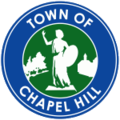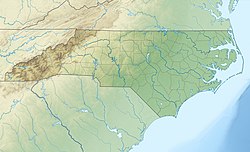2020 census
As of the 2020 census, there were 61,960 people, 20,369 households, and 10,552 families residing in the town. Chapel Hill is a town largely known for its 4-year, public institution: The University of North Carolina at Chapel Hill. The proportion of alumni staying in the same metro area coming from a public 4-year institution is 47%, whereas the proportion of the same alum staying in the same state is 68%. [31] This data explains many of the unique demographic qualities of this town.
The demographic structure of Chapel Hill is further defined by its role within the Research Triangle region. While the university attracts a continuous flow of young adults, the broader metro area is a powerful magnet for retaining and attracting skilled workers in science and technology fields. This creates a dynamic where Chapel Hill serves as an initial feeder for future professionals, with many graduates subsequently migrating to other parts of the Triangle for employment, contributing to the regions overall gain even as the town itself experiences a constant cycle of student in- and out-migration.
As of 2023, Chapel Hill had a population of 59,889. The median age in Chapel Hill was 25.8 years, dramatically lower than the North Carolina state median of 39.1. [32] This is one of the lowest median ages of any incorporated municipality in the state and is direct reflection of the university’s large student population.
The town exhibits a distinct economic profile common to major college towns. These are characterized by a paradox of high median income along with high poverty rate. The 2023 median household income was $85,825, which is about 25% higher than the state median. Conversely, the poverty rate was 19.6%. This is quite a bit higher than the state average of 13.2%. [33] The statistical contrast can be attributed to the inclusion of the student population. As is common for students, many have little to no personal income. The largest sectors of employment were Educational Services, Professional, Scientific, and Technical Services, and Health Care and Social Assistance. This profile is mainly spurred by the reputation of the educational institution of UNC as a research hub.
The five largest ethnic groups in Chapel Hill are White (Non-Hispanic), Asian (Non-Hispanic), Black or African American (Non-Hispanic), individuals of two or more races (Non-Hispanic), and White (Hispanic) (see figure 1). The foreign-born population accounts for 14.9% of residents, and 91.8% of the population are US citizens. [33]
The town has a highly educated population, with over 77% of all adult residents holding a bachelor’s degree or higher, more than double the state average of 34.7%. Given the largest areas of employment and the large university, the disparity between the state population averages and the town population average is not an unexplainable phenomenon. [33]
The housing market in Chapel Hill is characterized by high costs and a high proportion of renters, consistent with a transient student and academic population. The median property value was $576,500, more than double the North Carolina median. The homeownership rate was 48.7%, with renter-occupied households slightly outnumbering owner-occupied households. [33]
The average commute time was 19.6 minutes, shorter than the state average. The most common means of transportation to work were driving alone at 48.1%, working from home at 27.1%, and walking at 7.7%. [33]
2010 census
At the 2010 census, there were 57,233 people in 20,564 households residing in the town. The population density was 2,687 people per square mile (1,037 people/km2). The racial composition of the town was 72.8% White, 9.7% African American, 0.3% Native American, 11.9% Asian, 0.02% Pacific Islander, 2.7% some other race, and 2.7% of two or more races. About 6.4% of the population was Hispanic or Latino of any race. [34]
Of the 20,564 households, 51.1% were families, 26.2% of all households had children under the age of 18 living with them, 40.2% were headed by married couples living together, 8.2% had a female householder with no husband present, and 48.9% were not families. About 30.6% of all households were made up of individuals, and 7.7% had someone living alone who was 65 years of age or older. The average household size was 2.35 and the average family size was 2.98. [34]
In the town, the population was distributed as 17.4% under the age of 18, Individuals aged 18–24 make up the single largest age group consisting of 31.5%, 23.6% from 25 to 44, 18.4% from 45 to 64, and 9.2% who were 65 years of age or older. The median age was 25.6 years. For every 100 females, there were 87.2 males. For every 100 females age 18 and over, there were 83.6 males. [34]
According to estimates released by the U.S. Census Bureau, over the three-year period of 2005 through 2007, the median income for a household in the town was $51,690, and for a family was $91,049. [35] Males had a median income of $50,258 versus $32,917 for females. The per capita income for the town was $35,796. About 8.6% of families and 19.8% of the population were below the poverty line, including 8.6% of those under age 18 and 5.6% of those age 65 or over.
Chapel Hill is North Carolina's best-educated municipality, proportionately, with 77% of adult residents (25 and older) holding an associate degree or higher, and 73% of adults possessing a baccalaureate degree or higher. [36]
















